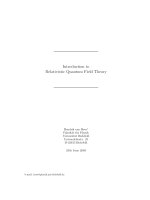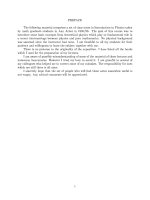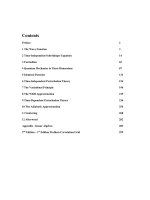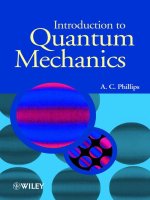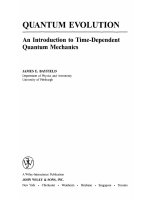- Trang chủ >>
- Khoa Học Tự Nhiên >>
- Vật lý
Introduction to quantum optics; from light quanta to quantum teleportation
Bạn đang xem bản rút gọn của tài liệu. Xem và tải ngay bản đầy đủ của tài liệu tại đây (2.29 MB, 255 trang )
This page intentionally left blank
www.pdfgrip.com
INTRODUCTION TO QUANTUM OPTICS
From Light Quanta to Quantum Teleportation
The purpose of this book is to provide a physical understanding of what photons
are and of their properties and applications. Special emphasis is made in the text on
photon pairs produced in spontaneous parametric down-conversion, which exhibit
intrinsically quantum mechanical correlations known as entanglement, and which
extend over manifestly macroscopic distances. Such photon pairs are well suited to
the physical realization of Einstein–Podolsky–Rosen-type experiments, and also
make possible such exciting techniques as quantum cryptography and teleportation. In addition, non-classical properties of light, such as photon antibunching
and squeezing, as well as quantum phase measurement and optical tomography,
are discussed. The author describes relevant experiments and elucidates the physical ideas behind them. This book will be of interest to undergraduates and graduate
students studying optics, and to any physicist with an interest in the mysteries of
the photon and exciting modern work in quantum cryptography and teleportation.
H A R R Y P A U L obtained a Ph.D. in Physics at Friedrich Schiller University, Jena,
in 1958. Until 1991 he was a scientific coworker at the Academy of Sciences at
Berlin. Afterwards he headed the newly created research group Nonclassical Light
at the Max Planck Society. In 1993 he was appointed Professor of Theoretical
Physics at Humboldt University, Berlin. He retired in 1996.
Harry Paul has made important theoretical contributions to quantum optics. In
particular, he extended the conventional interference theory based on the concept
of any photon interfering only with itself to show also that different, independently produced photons can be made to interfere in special circumstances. He
was also the first to propose a feasible measuring scheme for the quantum phase
of a (monochromatic) radiation field. It relies on amplification with the help of a
quantum amplifier and led him to introduce a realistic phase operator.
Harry Paul is the author of textbooks on laser theory and non-linear optics, and
he is editor of the encyclopedia Lexikon der Optik.
www.pdfgrip.com
www.pdfgrip.com
INTRODUCTION TO QUANTUM OPTICS
From Light Quanta to Quantum Teleportation
HARRY PAUL
Translated from German by
IGOR JEX
www.pdfgrip.com
cambridge university press
Cambridge, New York, Melbourne, Madrid, Cape Town, Singapore, São Paulo
Cambridge University Press
The Edinburgh Building, Cambridge cb2 2ru, UK
Published in the United States of America by Cambridge University Press, New York
www.cambridge.org
Information on this title: www.cambridge.org/9780521835633
© German edition: B. G. Teubner GmbH, Stuttgart/Leipzig/Wiesbaden 1999
English translation: Cambridge University Press 2004
This publication is in copyright. Subject to statutory exception and to the provision of
relevant collective licensing agreements, no reproduction of any part may take place
without the written permission of Cambridge University Press.
First published in print format 2004
isbn-13
isbn-10
978-0-511-19475-7 eBook (EBL)
0-511-19475-7 eBook (EBL)
isbn-13
isbn-10
978-0-521-83563-3 hardback
0-521-83563-1 hardback
Cambridge University Press has no responsibility for the persistence or accuracy of urls
for external or third-party internet websites referred to in this publication, and does not
guarantee that any content on such websites is, or will remain, accurate or appropriate.
www.pdfgrip.com
To Herbert Walther, with heartfelt gratitude
www.pdfgrip.com
www.pdfgrip.com
Contents
Preface
1 Introduction
2 Historical milestones
2.1 Light waves a` la Huygens
2.2 Newton’s light particles
2.3 Young’s interference experiment
2.4 Einstein’s hypothesis of light quanta
3 Basics of the classical description of light
3.1 The electromagnetic field and its energy
3.2 Intensity and interference
3.3 Emission of radiation
3.4 Spectral decomposition
4 Quantum mechanical understanding of light
4.1 Quantum mechanical uncertainty
4.2 Quantization of electromagnetic energy
4.3 Fluctuations of the electromagnetic field
4.4 Coherent states of the radiation field
5 Light detectors
5.1 Light absorption
5.2 Photoelectric detection of light
5.3 The photoeffect and the quantum nature of light
6 Spontaneous emission
6.1 Particle properties of radiation
6.2 The wave aspect
6.3 Paradoxes relating to the emission process
6.4 Complementarity
6.5 Quantum mechanical description
6.6 Quantum beats
vii
www.pdfgrip.com
page xi
1
3
3
5
9
12
17
17
19
22
24
29
29
33
38
39
41
41
43
48
59
59
63
67
69
71
77
viii
7
8
9
10
11
12
13
14
15
Contents
6.7 Parametric fluorescence
6.8 Photons in “pure culture”
6.9 Properties of photons
Interference
7.1 Beamsplitting
7.2 Self-interference of photons
7.3 Delayed choice experiments
7.4 Interference of independent photons
7.5 Which way?
7.6 Intensity correlations
7.7 Photon deformation
Photon statistics
8.1 Measuring the diameter of stars
8.2 Photon bunching
8.3 Random photon distribution
8.4 Photon antibunching
Squeezed light
9.1 Quadrature components of light
9.2 Generation
9.3 Homodyne detection
Measuring distribution functions
10.1 The quantum phase of light
10.2 Realistic phase measurement
10.3 State reconstruction from measured data
Optical Einstein–Podolsky–Rosen experiments
11.1 Polarization entangled photon pairs
11.2 The Einstein–Podolsky–Rosen paradox
11.3 Hidden variables theories
11.4 Experimental results
11.5 Faster-than-light information transmission?
11.6 The Franson experiment
Quantum cryptography
12.1 Fundamentals of cryptography
12.2 Eavesdropping and quantum theory
Quantum teleportation
13.1 Transmission of a polarization state
13.2 Transmission of a single-mode wave function
Summarizing what we know about the photon
Appendix. Mathematical description
15.1 Quantization of a single-mode field
www.pdfgrip.com
79
82
84
87
87
91
97
98
108
117
123
127
127
134
141
145
155
155
157
160
165
165
166
174
177
177
182
183
190
193
196
201
201
202
207
207
211
215
219
219
Contents
15.2 Definition and properties of coherent states
15.3 The Weisskopf–Wigner solution for spontaneous emission
15.4 Theory of beamsplitting and optical mixing
15.5 Quantum theory of interference
15.6 Theory of balanced homodyne detection
References
Index
www.pdfgrip.com
ix
222
226
228
232
234
235
240
www.pdfgrip.com
Preface
All the 50 years of conscious pondering did not bring me nearer to the
answer to the question “What are light quanta”. Nowadays every rascal
believes, he knows it, however, he is mistaken.
Albert Einstein
(1951 in a letter to M. Besso)
The rapid technological development initiated by the invention of the laser, on the
one hand, and the perfection attained in the fabrication of photodetectors, on the
other hand, gave birth to a new physical discipline known as quantum optics. A
variety of exciting experiments suggested by ingenious quantum theorists were
performed that showed specific quantum features of light. What we can learn from
those experiments about the miraculous constituents of light, the photons, is a central question in this book. Remarkably, the famous paradox of Einstein, Podolsky
and Rosen became a subject of actual experiments too. Here photon pairs produced
in entangled states are the actors.
The book gives an account of important achievements in quantum optics. My
primary goal was to contribute to a physical understanding of the observed phenomena that often defy the intuition we acquired from our experience with classical physics. So, unlike conventional textbooks, the book contains much more
explaining text than formulas. (Elements of the mathematical description can be
found in the Appendix.) The translation gave me a welcome opportunity to update the book. In particular, chapters on the Franson experiment and on quantum
teleportation have been included.
I expect the reader to have some knowledge of classical electrodynamics,
especially classical optics, and to be familiar with the basic concepts of quantum
theory.
xi
www.pdfgrip.com
xii
Preface
I am very grateful to my colleague Igor Jex from the Technical University of
Prague, who was not discouraged from translating my sometimes rather intricate
German text. (Interested readers may like to consult Mark Twain’s “The Awful
German Language” in Your Personal Mark Twain (Berlin, Seven Seas Publishers,
1960).)
Harry Paul
(Berlin, September 2003)
www.pdfgrip.com
1
Introduction
And the Lord saw that the light was good.
Genesis 1:4
Most probably all people, even though they belong to different cultures, would
agree on the extraordinary role that light – the gift of the Sun-god – plays in nature
and in their own existence. Optical impressions mediated by light enable us to
form our views of the surrounding world and to adapt to it. The warming power of
the sun’s rays is a phenomenon experienced in ancient times and still appreciated
today. We now know that the sun’s radiation is the energy source for the life cycles
on Earth. Indeed, it is photosynthesis in plants, a complicated chemical reaction
mediated by chlorophyll, that forms the basis for organic life. In photosynthesis
carbon dioxide and water are transformed into carbohydrates and oxygen with the
help of light. Our main energy resources, coal, oil and gas, are basically nothing
other than stored solar energy.
Finally, we should not forget how strongly seeing things influences our concepts
of and the ways in which we pursue science. We can only speculate whether the
current state of science could have been achieved without sight, without our ability
to comprehend complicated equations, or to recognize structures at one glance and
illustrate them graphically, and record them in written form.
The most amazing properties, some of which are completely alien to our common experiences with solid bodies, can be ascribed to light: it is weightless; it
is able to traverse enormous distances of space with incredible speed (Descartes
thought that light spreads out instantaneously); without being visible itself, it creates, in our minds, via our eyes, a world of colors and forms, thus “reflecting”
the outside world. Due to these facts it comes as no surprise that optical effects confronted our knowledge-seeking mind with more difficult problems than
those of moving material objects. Over several hundred years a bitter war was
fought between two parties. One group, relying on Newton’s authority, postulated
1
www.pdfgrip.com
2
Introduction
the existence of elementary constituents of light. The other, inspired by the ideas
of Huygens, fought for light as a wave phenomenon. It seemed that the question
was ultimately settled in favor of the wave alternative by Maxwell’s theory, which
conceived light as a special form of the electromagnetic phenomena. All optical
phenomena could be related without great difficulty and to a high degree of accuracy to special solutions of the basic equations of classical electrodynamics, the
Maxwell equations.
However, not more than 40 years passed and light phenomena revealed another
surprise. The first originated in studies of black-body radiation (radiation emitted
from a cavity with walls held at a constant temperature). The measured spectral
properties of this radiation could not be theoretically understood. The discrepancy
led Max Planck to a theory which brought about a painful break with classical
physics. Planck solved the problem by introducing as an ad hoc hypothesis the
quantization of energy of oscillators interacting with the radiation field.
On the other hand, special features of the photoelectric effect (or photoeffect)
led Einstein to the insight that they are most easily explained by the “light quantum
hypothesis”. Based on an ingenious thermodynamic argument Einstein created the
concept of a light field formed from energy quanta hν localized in space (h is
Planck’s constant and ν is the light frequency).
The newly created model was fully confirmed in all its quantitative predictions by studies of the photoeffect that followed, but there was also no doubt that
many optical phenomena like interference and diffraction can be explained only as
wave phenomena. The old question, Is light formed from particles or waves?, was
revived on a new, higher level. Even though painful for many physicists, the question could not be resolved one way or the other. Scientists had to accept the idea
that light quanta, or photons as they were later called, are objects more complicated than a particle or a wave. The photon resembles a Janus head: depending on
the experimental conditions it behaves either like a particle or as a wave. We will
face this particle–wave dualism several times in the following chapters when we
analyze different experiments in our quest to elucidate the essence of the photon.
Before this, let us take a short stroll through the history of optics.
www.pdfgrip.com
2
Historical milestones
2.1 Light waves a` la Huygens
While the geometers derive their theorems from secure and unchallengeable principles, here the principles prove true through the deductions one
draws from them.
Christian Huygens
(Trait´e de la Lumi´ere)
Christian Huygens (1629–1695) is rightfully considered to be the founder of the
wave theory of light. The fundamental principle enabling us to understand the
propagation of light bears his name. It has found its way into textbooks together
with the descriptions of reflection and refraction which are based on it.
However, when we make the effort and read Huygens’ Treatise of Light
(Huygens, 1690) we find to our surprise that his wave concept differs considerably from ours. When we speak of a wave we mean a motion periodic in space and
time: at each position the displacement (think about a water wave, for instance)
realizes a harmonic oscillation with a certain frequency ν, and an instantaneous
picture of the whole wave shows a continuous sequence of hills and valleys. However, this periodicity property which seems to us to be a characteristic of a wave
is completely absent in Huygens’ wave concept. His waves do not have either
a frequency or a wavelength! Huygens’ concept of wave generation is that of a
(point-like) source which is, at the same time, the wave center inducing, through
“collisions” that “do not succeed one another at regular intervals,” a “tremor” of
the ether particles. The given reason for wave propagation is that ether particles
thus excited “cannot but transfer this tremor to the particles in their surrounding” (Roditschew and Frankfurt, 1977, p. 31). Therefore, when Huygens speaks
of a wave, he means an excitation of the ether caused by a single perturbation in
the wave centrum, i.e. a single wavefront spreading with the velocity of light. The
plots drawn by Huygens showing wavefronts in an equidistant sequence have to be
3
www.pdfgrip.com
4
Historical milestones
+
Fig. 2.1. Propagation of a spherical wave according to the Huygens principle.
understood such that it is the same wavefront at different times, and the regularity
of the plot is caused exclusively by having chosen identical time differences.
In fact, what was correctly described in this way is white light – sunlight for
instance. The time dependence of the excitation – or more precisely speaking the
electric field strength component with respect to an arbitrarily chosen direction –
is not predictable but completely random (stochastic).
On the other hand, it is also clear that such a theory is not able to explain typical
wave phenomena such as interference or diffraction where the wavelength plays
an important role. It required Newton and his ingenious insight that natural light
is composed of light with different colors to come nearer to an understanding of
these effects.
This should not hinder us, however, from honoring Huygens’ great “model idea”
known as the Huygens principle according to which each point either in the ether or
in a transparent medium reached by a wave, more precisely a wavefront, becomes
itself the origin of a new elementary wave, as illustrated in Fig. 2.1 for the example
of a spherical wave.
The wavefront at a later time is obtained as the envelope of all elementary waves
emitted at the same, earlier, moment of time. However, Huygens could not answer
the question of why a backwards running wave is generated only at the boundary
of two different media and not also in a homogeneous medium (including the
ether). In fact, a satisfactory answer could not be given until Augustin Fresnel
complemented the principle with the principle of interference – we use today the
term Huygens–Fresnel principle – the strength of which is demonstrated when we
treat theoretically the problems of diffraction. By the way, the answer to the above
question is simple: the backwards running waves “interfere away.”
But let us return to Huygens! Using the assumption that light propagates in
two different media with different velocities, we can easily explain reflection and
www.pdfgrip.com
2.2 Newton’s light particles
e
5
o
Fig. 2.2. Birefringence after Huygens. o = ordinary beam; e = extraordinary
beam; the arrows indicate the beam direction.
refraction of light using the Huygens principle. The explanation of the strange effects of birefringence (the splitting of the incident beam into an ordinary and an
extraordinary beam) can be viewed as an extraordinary success of the principle. It
was based on the ingenious guess that the surfaces of propagation for the extraordinary beam are not spherical surfaces but the surfaces of a rotational ellipsoid
(see Fig. 2.2), an insight that is fully verified by modern crystallography. However,
Huygens had great difficulty understanding the experiments he performed with two
crystals of calcite. We will discuss this problem in more detail in the next section.
2.2 Newton’s light particles
As in mathematics, so in natural philosophy, the investigation of difficult
things by the method of analysis, ought ever to precede the method of
composition. This analysis consists in making experiments and observations, and in drawing general conclusions from them by induction, and
admitting of no objections against the conclusions, but such as are taken
from experiments, or other certain truths.
Isaac Newton
(Opticks, 3rd Book)
Isaac Newton (1643–1727) was the founder of the particle theory of light. Even
though the light particles postulated by Newton do not have anything in common
with what we now call photons, it is still exciting to trace back the considerations
which led such a sharp mind to the conclusion that light of certain color is composed of identical, elementary particles. As an abiding supporter of the inductive
method as the method of natural sciences, Newton was guided by a simple experience: the straight line propagation of light “rays,” recognizable on the sharp
www.pdfgrip.com
6
Historical milestones
contours of shadows of (nontransparent) objects placed into the beam path. This
effect seemed to Newton to be easily explained by assuming that the light source
emits tiny “bullets” propagating along straight lines until they interact with material objects. He believed a wave process to be incompatible with straight line
propagation of the excitation. Water waves showed a completely different type of
behavior: they obviously run around an obstacle!
Since the breakthroughs of Young and Fresnel it has been known that Newton’s
conclusion was premature. What happens when a wavefront hits an obstacle depends crucially on the ratio between the size of the obstacle and the wavelength.
When the ratio is very large, the wave character is not noticeable; in the limit of
very small wavelength the propagation of light can be described by straight lines,
i.e. light rays. On the other hand, wave properties become predominant when the
dimensions of the obstacle are of the order of the wavelength, as in the above
example of water waves.
Newton himself observed with impressive precision experimental phenomena
where the outer edge of a body (for instance the cutting edge of a razor) deflects
the light “rays” in its proximity a little from their original straight direction so that
no ideally sharp shadows are observable. He did not take these phenomena, now
called the diffraction of light, to be hints of a wave-like character of light; instead,
he considered the bending as the result of a force applied onto the particles (in
his opinion caused by the density of the ether increasing with increasing distance
from the object), an idea which was completely in accord with the well established
concepts of mechanics. Newton’s belief that light had a particle nature should be
judged from the perspective of the seventeenth century atomism, which was, at the
time, a deeply rooted concept. “True” physics – in contrast to scholasticism which
categorized light and color phenomena into the class of “forms and qualities” –
was imaginable only as a mechanical motion of particles under the influence of
external forces.
The most important argument expounded by Newton against the wave theory of
light advanced by Christian Huygens was, however, a very odd observation made
and reported by his great opponent (who even honestly admitted to have “found
no satisfactory explanation for it.”)
What was it? It is well known that a light beam is split by a calcite crystal
into an ordinary beam and an extraordinary beam and – provided it is incident
orthogonally to the rhombohedral plane – the latter beam is shifted to the side.
Then the two beams lie in one plane, the so-called principal intersection of the
incident beam.
Huygens arranged vertically two calcite crystals with different orientations and
let a light beam impinge from above. He made the following observation: usually both the ordinary and the extraordinary beam leaving the first crystal were
split again in the second crystal into two beams, an ordinary and an extraordinary
www.pdfgrip.com
2.2 Newton’s light particles
7
one. Only when the two crystals were oriented either so that the intersections were
mutually parallel or mutually orthogonal did just two beams emerge from the second crystal. Whereas in the first case the ordinary beam remained ordinary in the
second crystal (the same naturally applied also to the extraordinary beam), in the
second case, in contrast, the ordinary beam of the first crystal was converted into
the extraordinary beam of the second crystal, and correspondingly the extraordinary beam of the first crystal was converted into the ordinary.
These last two observations surprised Huygens. He wrote (Roditschew and
Frankfurt, 1977, p. 43): “It is now amazing why the beams coming from the air
and hitting the lower crystal do not split just as the first beam.” In the framework
of the wave theory of light – note that we are dealing with a scalar theory similar to the theory of sound, where the oscillations are characterized by alternating
expansions and compressions of the medium; at that time no one thought of a
possible transverse oscillation! – we face a real dilemma: a wave, using modern
terminology, is rotationally symmetric with respect to its propagation direction,
or, as Newton formulated it, “Pressions or motions, propagated from a shining
body through an uniform medium, must be on all sides alike” (Newton, 1730;
Roditschew and Frankfurt, 1977, p. 81). There does not seem to be a reason why
the ordinary beam leaving the first crystal, for example, should in any way “take
notice” of the orientation of the second crystal.
Newton saw a way of explaining the effect using his particle model of light. The
rotation symmetry can be broken by assuming the particles not to be rotationally
symmetric but rather to have a kind of “orientation mark.” The simplest possible
picture is the following: the light particles are not balls but cubes with physically
distinguishable sides, and the experiment suggests that opposite sides should be
considered equivalent. Newton himself is not explicit about the form of the particles, whether they are cubic or block-like, and is satisfied by ascribing to the light
particle four sides, the opposites of which are physically equivalent. We thus deal
with two pairs of sides, and Newton called one of these pairs the “sides of unusual
refraction.”
The orientation of the side pairs with respect to the principal intersection of
the calcite crystal determined in Newton’s opinion, the future of the light particle
when it enters the crystal in the following sense: depending on whether one of the
sides of the unusual refraction or one of the other sides is turned towards the “coast
of unusual refraction” (this means the orientation of the side is orthogonal to the
principal intersection plane), the particle undergoes an extraordinary or an ordinary
refraction. Newton emphasizes that this property of a light particle is present from
the beginning and is not changed by the refraction in the first crystal. The particles
remain the same also, and do not alter their orientation in space.
In detail, the observations of Huygens can now be explained as follows
(Fig. 2.3(a)): the original beam is a mixture of particles oriented one or the other
www.pdfgrip.com
8
Historical milestones
(a)
(b)
Fig. 2.3. Passage of a beam through two calcite crystals rotated by 90◦ . (a) Newton’s interpretation; (b) modern description. (The arrows indicate the direction of
the electric field strength.)
way with respect to the principal cut plane of the first crystal. The first crystal induces a separation of the particles, depending on their orientation, into an ordinary
beam and an extraordinary beam. When the crystals are oriented with their principal intersection planes in parallel, the orientations of the particles with respect to
the two crystals are identical. The ordinary beam of the first crystal is also the ordinary beam of the second, and the same applies to the extraordinary beam. However,
when the principal intersections of the crystals are mutually orthogonal, the orientation of the particles leaving the first crystal with respect to the second changes
so that the ordinary beam becomes the extraordinary beam, and vice versa.
With this penetrating interpretation of Huygens’s experiment, in fact Newton
succeeded in describing phenomenologically polarization properties of light.
Even the name “polarization” was coined by Newon – a fact that is almost forgotten now. (He saw an analogy to the two poles of a magnet.) Today it is well
known that the direction to which the “sides of unusual refraction” postulated by
Newton points is physically nothing else than the direction of the electric field
strength (see Fig. 2.3(b)).
Even though Newton’s arguments in favor of a particle nature of light no longer
convince us, and the modern concept of photons is supported by completely different experimental facts which Newton could not even divine with his atomic
light concept, this ingenious researcher raised an issue which is topical even now.
Newton analyzed the simple process of simultaneous reflection and refraction
which is observable when a light beam is incident on the surface of a transparent medium. The particle picture describes the process in such a way that a certain
percentage of the incident particles is reflected while the rest enters the medium
www.pdfgrip.com
2.3 Young’s interference experiment
9
as the refracted beam. In the spirit of deterministic mechanics founded by him,
Newton asks what causes a randomly chosen particle to do the one or the other.
In fact, the problem is much more acute for us than for Newton because we are
now able to perform experiments with individual particles, i.e. photons. While
quantum theory sees blind chance at work, Newton postulated the cause of the
different behavior to be “fits of easy reflection” and “fits of easy transmission”
into which the particles are probably already placed during the process of their
emission. These “fits” show a remarkable similarity to the “hidden variables” of
the twentieth century which were advocated (as it turned out, unsuccessfully) to
overcome the indeterminism of the quantum mechanical description.
We would not be justified, however, in considering Newton, one of the founders
of classical optics, to be a blind advocate of the particle theory of light. On the
contrary, he was well aware that various observations are understandable only
with the aid of a kind of wave concept. He formulated his thoughts in the form of
queries with which he supplemented later editions of his Opticks (Newton, 1730;
Roditschew and Frankfurt, 1977, p. 45), and all of them were characteristically
formulated in the grammatical form of negations. It seemed to him that along with
the light particles, waves propagating in the “ether” also take part in the game.
Is it not so, he asks, that light particles emitted by a source must excite oscillations of the ether when they hit a refracting or reflecting surface, similar to stones
being thrown into water? This idea helped him to understand the colors of thin
layers which he studied very carefully, mainly in the form of rings formed on soap
bubbles (which were named after him).
Altogether we find so many hints for a wave nature of light in Newton’s
Opticks that Thomas Young could cite Newton as “king’s evidence” for the wave
theory in his lecture “On the theory of light and colours” (Young, 1802;
Roditschew and Frankfurt, 1977, p. 153). Even though Young definitely missed
the point, it would be just to see Newton as one of the forerunners advocating the
dualistic concept that light has a particle as well as a wave aspect (even though he
gave emphasis to the first one). From this point of view, Newton seems to us much
more modern and nearer in mentality to us than to most of the representatives of
nineteenth century physics who were absolutely convinced of the validity of the
wave picture.
2.3 Young’s interference experiment
The theory of light and colours, though it did not occupy a large portion
of my time, I conceived to be of more importance than all that I have
ever done, or ever shall do besides.
Thomas Young
www.pdfgrip.com
10
Historical milestones
interference
screen
light
source
intensity
distribution
observation
screen
Fig. 2.4. Young’s interference experiment.
Interference phenomena are viewed as the most convincing “proof” of the wave
nature of light. The pioneering work in this field was carried out by Thomas Young
(1773–1829) and, independently, by Augustin Fresnel (1788–1827). It was Young,
despite his work going practically unnoticed by his contemporaries, who performed the first interference experiment which found its way into all the textbooks.
The principle of the experiment is the spatial superposition of two (we would say
coherent) light beams. This is achieved by using an almost point-like monochromatic source and allowing its light to fall onto an opaque screen with two small
holes or slits (Fig. 2.4). The two holes themselves become secondary sources of
radiation, but because they are excited by the same source they do not radiate independently. We can now position an observation screen at a convenient distance
from and parallel to the first screen and we will observe, near the point where
the normal (constructed precisely at the center of the straight line connecting the
two holes) intersects the observation plane, a system of mutually parallel bright
and dark stripes (orthogonal to the aforementioned connecting line), the so-called
interference fringes.
The distance (which is always the same) between neighboring stripes depends
primarily on the distance between the holes – it is larger when the holes are closer
together – and secondly on the color of the light; when we work with sunlight
we obtain colored stripes which become superposed at a certain distance from the
center of the interference pattern, and the eye gets the impression of a surface
uniformly illuminated by white light.
The surprising feature of this observation (let us consider again a monochromatic primary source) is the existence of positions that appear dark even though
they are simultaneously illuminated by both holes. When one of the holes is
blocked, the interference fringes vanish and the observation screen looks uniformly
www.pdfgrip.com
2.3 Young’s interference experiment
11
bright. So, adding light from another hole actually decreases the intensity of the
light at some points (so creating the interference fringes).
To stress this point, under certain conditions an equation of the form “light +
light = darkness” must hold. However, such a statement is naturally completely
incompatible with a particle picture of light as put forward by Newton: when particles are added to those already present, the brightness can only increase. Otherwise
the particles would have to “annihilate” each other, which sounds rather odd and
contradicts our experience that crossed beams of light mutually penetrate without
influencing each other. Thus, the particle picture seems to have been reduced to
absurdity.
However, the interference effects are easily explained by the wave picture: when
two wave trains (of equal intensity) overlap in certain regions of space, it is certainly possible that the instantaneous “displacement” of one of the waves, compared with the other, is equal in amplitude but opposite in direction (i.e. they are
out of phase). In such a case, as is easily demonstrated by water waves, the two
displacements balance one another and the medium remains at rest. On the other
hand, at positions where the waves oscillate “in phase” (their displacements have
the same amplitudes and direction) the waves are maximally amplified. Obviously
there is a continuous transition between these two limiting cases.
Based on these concepts, Young was able to give a quantitatively correct description of his interference experiment (Young, 1807):
The middle . . . is always light, and the bright stripes at each side are at such distances, that
the light coming to them from one of the apertures must have passed through a longer
space than that which comes from the other, by an interval which is equal to the breadth1
of one, two, three or more, of the supposed undulations, while the intervening dark spaces
correspond to a difference of half a supposed undulation, of one and a half, of two and a
half, or more.
With this interpretation of his observations Young determined the wavelength
to be approximately 1/36 000 inch for red light and approximately 1/60 000 inch
for violet light, values that agree quite well with known data.
It should be emphasized that the explanation of the interference using the wave
concept is independent of the concrete physical mechanism of wave phenomena.
In fact, in Young’s and Fresnel’s days, the physical nature of the oscillatory process
taking place was not clear; using the words of the Marquis of Salisbury, scientists
were “in search for the nominative of the verb to undulate” (to move like a wave).
The quest was successfully completed only by the discovery of the electromagnetic
nature of light by James Clerk Maxwell (1831–1879).
1 We would say wavelength.
www.pdfgrip.com


